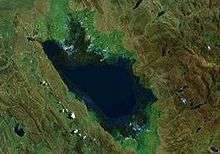Lake Junin
| Lake Junin | |
|---|---|
| Chinchayqucha | |
 | |
| Coordinates | 11°01′S 76°07′W / 11.017°S 76.117°WCoordinates: 11°01′S 76°07′W / 11.017°S 76.117°W |
| Primary outflows | Upamayu-Mantaro River |
| Basin countries | Peru |
| Surface area | 529.88 square kilometres (204.59 sq mi) |
| Surface elevation | 4,082 metres (13,392 ft) |
Lake Junin[1] (who-neen; IPA: [xuˈnin]) (Spanish Lago Junín, named after the nearby town of Junin)[2] or Chinchayqucha (Quechua chincha, chinchay north, northern, chinchay ocelot, qucha lake, lagoon,[3][4] "northern lake" or "ocelot lake", hispanicized spelling Chinchaycocha) is the largest lake entirely within Peruvian territory. Even though Lake Titicaca has a much larger area, its eastern half is located on Bolivian territory. Lake Junin is an important birdwatching destination in the country.[5]
Geography

Most of the lake is located in the Junin Province of the Junin Region, its northwestern tip belongs to the Pasco Province which is in the Pasco Region. It is located at approximately 4,082 metres (13,392 ft) above sea level.
Lake Junin is surrounded by emergent vegetation, which in some places can reach 6 km wide and become so dense that it is impenetrable. The fish fauna is abundant but includes several introduced species. The introduced trout have been implicated in the decline of some native species.[6]
The lake is within the Amazon catchment. There is a hydroelectric power station which regulates the water level of the lake at the outflow of the lake, through the Upamayu Dam. In years of abundant rains, fluctuations in the water level are moderate, but in years of drought water level may drop 1.5–2 metres (4.9–6.6 ft) leaving extensive areas exposed.
Pollution
Since 1933 there has been an inflow of mining residues into the lake, which has adversely affected the fish and bird fauna in parts of the lake. Sewage coming from the cities of Junín and Carhuamayo also pollutes the lake. These types of pollution are contributing to the natural eutrophication process of this wetland.
Fauna
Lake Junin has two endemic birds: the critically endangered Junín flightless grebe (Podiceps taczanowskii) and the endangered Junín rail (Laterallus tuerosi).[7] The two endangered species of frogs in the genus Batrachophrynus are restricted to the vicinity of the lake, although only one of these, the entirely aquatic Lake Junín giant frog (B. macrostomus), is found in the lake itself.[6] Two Orestias pupfish, O. empyraeus and O. polonorum, are endemic to the lake basin.
See also
References
- ↑ Peru 1:100 000, Ondores (23-k). IGN (Instituto Geográfico Nacional - Perú).
- ↑ Gobierno Regional de Junín, Plan de Desarrollo Regional Concertado Junín 2004-2007
- ↑ Teofilo Laime Ajacopa, Diccionario Bilingüe Iskay simipi yuyayk'ancha, La Paz, 2007 (Quechua-Spanish dictionary): chincha. s. Norte. Punto cardinal. qucha, qhucha, quchacha. - s. Laguna. Lago pequeño. qucha, qhucha. - s. Lago. Gran masa de agua en una depresión.
- ↑ Diccionario Quechua - Español - Quechua, Academía Mayor de la Lengua Quechua, Gobierno Regional Cusco, Cusco 2005 (5-vowel-system): Chinchayqocha - s. Geog. (Topón. chincha, norte; qocha, lago: lago del norte.) Lago de considerables dimensiones en la meseta de Bombón en el departamento de Junín, Perú. chinchay - s. Zool. (Felis pardalis aequatorialis). Tigrillo. Orden carnívora, familia felidae. || v. Dirigir u orientar algo hacia el norte.
- ↑ "Lago de Junin". Birdlife Data Zone. Birdlife International. Retrieved 25 January 2016.
- 1 2 Stuart, Hoffmann, Chanson, Cox, Berridge, Ramani and Young, editors (2008). Threatened Amphibians of the World. ISBN 978-84-96553-41-5
- ↑ Schulenberg, Stotz, Lane, O'Neill, and Parker III. (2007). Birds of Peru. ISBN 978-0-7136-8673-9
| Wikimedia Commons has media related to Lake Junin. |